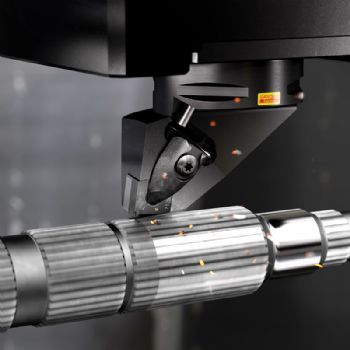
Machine shops working with transmission components and other hard-turned parts have reason to invest in the latest CBN (cubic boron nitride) technologies.
New developments in this area from Sandvik Coromant (
www.sandvik.coromant.com) have been designed to add value in terms of enhanced speed capabilities, while providing a more-secure ‘edge line’ and consistent tool life.
These attributes combine to reduce the cost per component — particularly when aiming for a one-cut strategy (a single cut with large chip thickness).
In the automotive industry, hard-part turning has become a widely adopted and cost-effective alternative to grinding, reducing machining time and costs — and offering further benefits.
For example: production is simplified, in that the process is similar to normal turning; better machine utilisation is achieved by using the same machine for both external and internal operations; and complex parts can be machined in a single set-up.
The process is also more environment-friendly, in that there is no coolant or grinding waste to contend with.
Hard-part turning requires the use of inserts based on CBN grades that are proven to retain their edge line despite high cutting temperatures and forces.
The latest Sandvik Coromant CB7125 and CB7135 insert grades complement the existing CB7105 and CB7115 grades to give the automotive sector a “complete portfolio of grade technologies to suit all hard-part turning requirements”.
Typical components that can be machined using such grades include shaft gears, pinions, crown wheels and CV-joints.
The two latest grades (CB7125 and CB7135) are for medium-to-heavy interrupted cuts in case-hardened and induction-hardened steel components; the existing grades CB7105 and CB7115 are designed for continuous or continuous-to-light interrupted cutting applications.
Each grade is designed to offer long and predictable tool life, good levels of surface finish and consistent dimensional tolerances in steels with a hardness of 58-62HRC.
Tool coating
Developed for medium intermittent cutting, CB7125 features a new PVD coating that provides improved wear- and fracture-resistance for extended tool life; this grade also has a “medium CBN content” and is suited to turning chamfered gears and splines, as well as gear facing and the removal of hardened layers.
A recent customer trial saw a CB7125 insert undertake external axial turning and facing on a case-hardened gear (62HRC) using a Mazak QTN 300 turning centre.
The trial showed that gains in tool life of 140% could be achieved compared with the customer’s existing insert, using the same cutting data for both inserts — a cutting speed of 120m/min, a feed rate of 0.12mm/rev and a 0.1mm depth of cut.
While both inserts achieved a metal removal rate of 1.44cm3/min in continuous cut, the competitor grade insert completed just five components before out-of-tolerance conditions were reached; the CB7125 insert achieved 12 components.
The same insert grade was put to the test against another competitor insert when undertaking external turning (with interrupted cutting) on the inner race of a CV joint (60HRC).
Here, a 15% gain in tool life was achieved, which is still a significant increase for manufacturers in the automotive sector, where volumes are typically high.
The Sandvik Coromant grade insert completed 1,272 parts, compared with 1,106 by the competitor. The cutting data included a cutting speed of 160m/min and a feed rate of 0.19mm/rev.
Fracture-resistance
The other newly introduced grade — CB7135 — targets the efficient turning of gears and shafts with un-chamfered keyways or pockets, as well as CV-joint components such as the inner/outer race and cage.
This grade features a high CBN content and offers a high level of resistance to fracturing, along with predictable machining results.
In a recent customer trial, internal turning (with interrupted cutting) on the outer race of a CV joint (C53 steel induction-hardened to 60HRC) using an EMAG VSC400 vertical pick-up turning centre provided a 12% increase in tool life. Some 390 parts were completed by the CB7135 grade insert, compared with 350 by a competitor insert.
Similar gains have been achieved with Sandvik’s two existing CBN grades — CB7105 and CB7115. CB7105 allows machine shops to achieve lower cost per part when used as part of a high-speed machining strategy, as the grade is suitable for continuous cutting operations, using shallow depths of cut and small chip loads at high speed.
Alternatively, users of CB7105 can benefit from longer tool life at lower speeds.
CB7115 is also designed to deliver lower cost per component, typically through the use of one-cut strategies at higher speeds. This grade is more suitable for continuous-to-light interrupted cuts, or larger chip loads at medium-to-high speeds.
Not all the gains highlighted are exclusively as a result of the grade; careful edge preparation and geometry also play their part, as they can provide the best balance between long tool life and reliable machining.
For example, a standard nose radius will generate the lowest cutting forces and has the lowest stability requirements, while wiper and Xcel geometries are designed to deliver high levels of productivity and surface finish.
Indeed, insert nose radius is a very important performance parameter. A small nose radius (0.2-0.4mm) provides good chip breaking, while a large nose radius (0.8-1.2mm) generates a better surface finish and produces thinner chips, which in turn reduces the degree of crater wear.
The new grades can be used with the Sandvik Coromant T-Max P, CoroTurn 107 and CoroTurn TR tools. Wiper, Xcel, light and strong edge preparations are available.